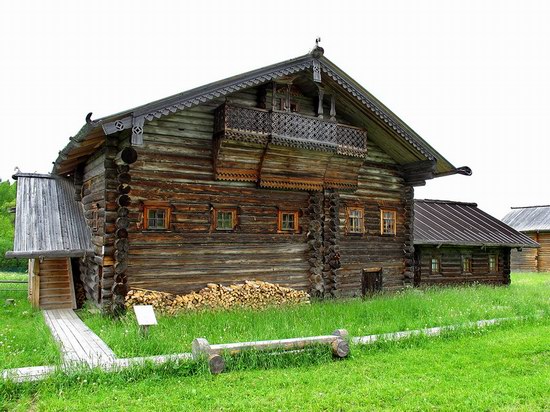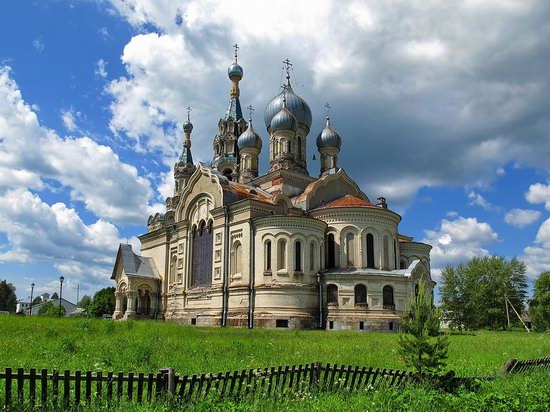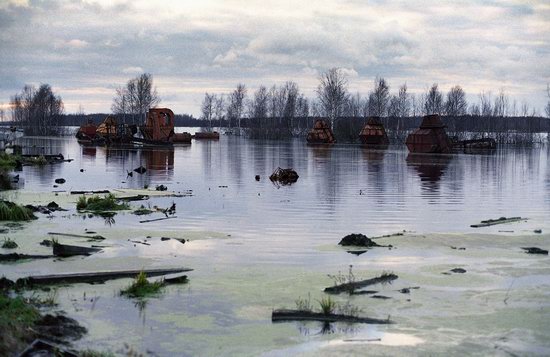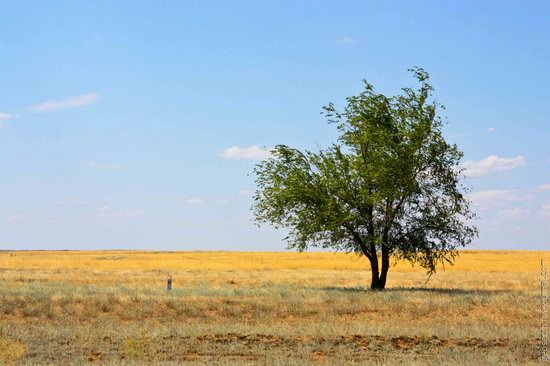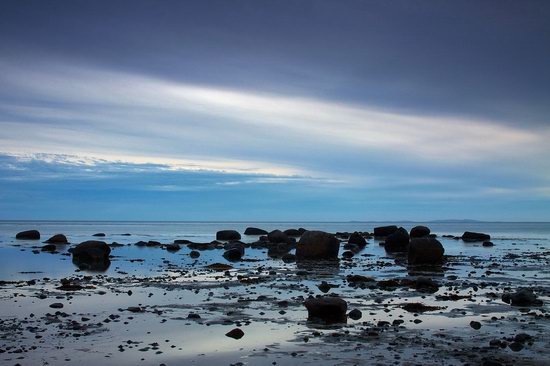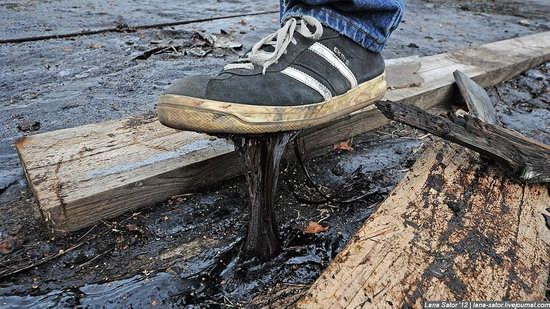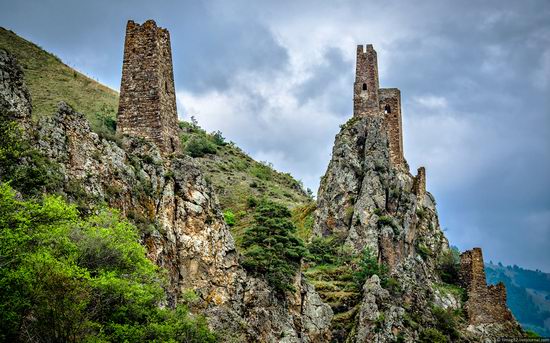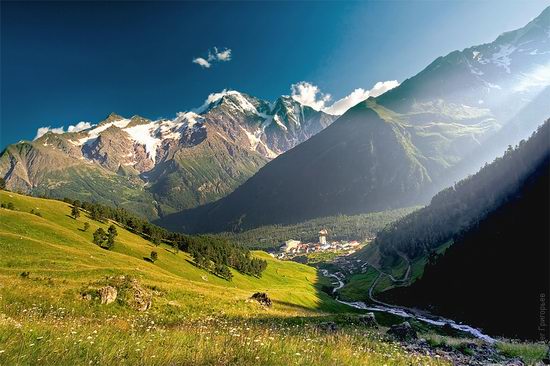CAT | Regions
14
Architectural and Ethnographic Museum “Semyonkovo”
1 Comment · Posted by Sergei Rzhevsky in Culture, Photos, Regions
Architectural and Ethnographic Museum of the Vologda region “Semyonkovo” invites you into the world of the Russian village of the late 19th – the early 20th centuries. Here you can learn more about the traditions, cultural background, and mentality of the Russian people.
The museum was opened in 1979. It is a monument of national value. The museum covers an area of 12.7 hectares and has a lot of monuments of wooden architecture of the middle 19th – the early 20th centuries. Photos by Denis Spirin
Tags: museum · Vologda oblast
9
Pearl of Russian temple architecture in Kukoboy village
1 Comment · Posted by Sergei Rzhevsky in Architecture, Photos, Regions, Religion
This majestic Savior Cathedral, built in the early 20th century, is standing in the center of the small village Kukoboy (population about 1,000). The cathedral is a picturesque temple constructed in high artistic style.
It is considered one of the most beautiful churches in Yaroslavl region and in all Russia. The temple impresses in its beauty and amazing proportions, rich ornamentation of white facing stone. Photos by Denis Spirin
Tags: churches · Yaroslavl oblast
4
Abandoned peat extraction site near Moscow
No comments · Posted by Sergei Rzhevsky in Nature, Photos, Regions
Earlier this place, located in the north of the Moscow region, was Olkhovskoye swamp. In 1936, the swamp was drained, and peat extraction began in 1955.
In 2010, one of the sites began to fill with water because of its depletion. A lot of different machines for peat extraction were left creating a very beautiful post-apocalyptic landscape now. Photos by rotweller
Tags: Abandoned · Moskovskaya oblast
15
Perm – the region of contrasts
No comments · Posted by Alex Smirnov in Cities, Regions, Video
Perm is a city in the east of the European part of Russia, in the foothills of the Urals, the administrative center of Perm Krai. The city is a major industrial, scientific, cultural, and logistic center of the Urals.
Perm was founded in 1723. In 1876, first in the Urals and Siberia railroad was built through the city. In 1979, the city’s population exceeded 1 million people.
In 2009, the authorities of the region started an ambitious project – “Perm – Cultural Capital.” The project significantly increased the number of cultural events held in the city, a lot of various art objects appeared in the streets.
Tags: Perm city · Perm krai · time-lapse
7
Unique nature of Astrakhan oblast
2 Comments · Posted by Sergei Rzhevsky in Nature, Photos, Regions
The nature of Astrakhan region is unique for Russia. Nowhere else in the country will you be able to find a territory composed of semi-deserts and deserts, where camels live, and the most famous Russian river Volga carries its waters.
Astrakhan oblast is located in the south-east of the East European Plain. The region is situated in the Caspian lowland where the Volga River flows into the Caspian Sea. The region stretches over 400 km in the form of a narrow stripe. Photos by GeoSerzh
Tags: Astrakhan oblast · landscapes
28
Severe beauty of one of the coldest seas of Russia
No comments · Posted by Sergei Rzhevsky in Nature, Photos, Regions
The White Sea is an inland sea located in the north of the European part of Russia (washes the shores of Karelia and Arkhangelsk region), refers to the Arctic Ocean. Of the seas surrounding Russia, the White Sea is one of the smallest. The average water depth is 67 meters. All the sea is internal waters of Russia.
The temperature of the surface layer of sea water varies greatly depending on the season in different parts of the sea. In winter the temperature of the White Sea surface water is about -1,3 … -1,7 ° C in the center and north of the sea, up to -0,5 … -0,7 ° C in the bays. Photos by borh-84
Tags: Arkhangelsk oblast · Karelia Republic
13
The most polluted lake in the world located near Dzerzhinsk
4 Comments · Posted by Sergei Rzhevsky in Ecology, Photos, Regions
In the past it was a swamped karst chasm, and today it is one of the most polluted bodies of water on the planet known as the “Black Hole.”
The lake is located between Nizhny Novgorod and Dzerzhinsk, on the outskirts of Dzerzhinsk eastern industrial zone (coordinates 56.2635788 43.6624149, Google Maps location). The lake is surrounded by barbed wire with banning-warning labels. Photos by Lana Sator
Tags: Dzerzhinsk city · Nizhegorodskaya oblast
10
Polar Lights – magnificent natural phenomenon
No comments · Posted by Alex Smirnov in Nature, Regions, Video
Polar Lights or Northern Lights (Aurora Borealis) is a natural phenomenon of glowing (luminescence) of the upper layers of atmosphere of the planet that has magnetosphere, due to their interaction with charged particles of solar wind.
When viewed from the surface of the planet Aurora Borealis appears as a general rapidly changing glow of the sky or moving beams, stripes, etc. Duration of the phenomenon varies from tens of minutes to several days.
Here you can see Polar Lights captured on video in Murmansk oblast of Russia near the town of Apatity-Kirovsk. The author of the video is Valentin Zhiganov.
Tags: Murmansk oblast
14
Beautiful views of the mountainous Ingushetia
1 Comment · Posted by Sergei Rzhevsky in Nature, Photos, Regions
Ingushetia Republic is located in the northern part of Big Caucasus range, part of North Caucasus Federal District. The length of the region from north to south is 144 km, from west to east – 72 km.
The northern part of the region has steppe terrain, the southern – the mountainous terrain, which consists of ridges separated by valleys and gorges (the Caucasus Mountains). The highest point of the region is Mount Shan (4500 meters). Ingushetia is known for its tower buildings – historical and architectural monuments. Photos by timag82
Tags: Ingushetia Republic
6
Climbing up Mount Elbrus – the highest peak in Russia
2 Comments · Posted by Sergei Rzhevsky in Nature, Photos, Regions, Travel
Elbrus is a stratovolcano in the Caucasus (on the border of the republics of Kabardino-Balkaria and Karachay-Cherkessia). Elbrus is located north of the Greater Caucasus Mountain Range and is the highest peak in Russia. Also because the border between Europe and Asia is controversial, Mount Elbrus can also be the highest peak in Europe.
Elbrus is a saddle-shaped volcano with a two peaks. Western peak has an elevation of 5642 meters, Eastern – 5621 meters. The peaks are connected by a saddle (5200 meters), the distance between peaks is about 3 kilometers. By climbing classification Elbrus has rating 2A (snow and ice), climbing to the top of two peaks – 2B. Photos by Oleg Grigoryev.
Tags: Kabardino-Balkaria Republic · Karachay-Cherkessia Republic

